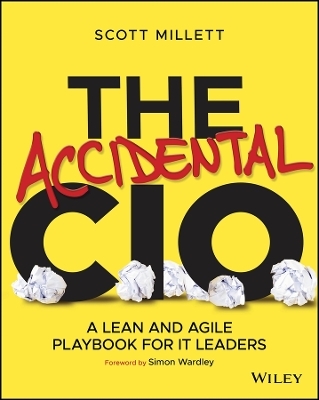
The Accidental CIO
John Wiley & Sons Inc (Verlag)
978-1-119-61209-4 (ISBN)
Many books on modern IT leadership focus solely on supporting innovation and disruption. In practice these must be balanced with the need to support waste reduction in existing processes and capabilities while keeping the foundation operational, secure, compliant with regulations, and cost effective.
In The Accidental CIO, veteran software developer-turned-executive Scott Millett delivers an essential playbook to becoming an impactful, strategic leader at any stage of your IT leadership journey from your earliest aspirations to long time incumbents in director and C-suite roles. You’ll find a wealth of hands-on advice for tackling the many challenges and paradoxes that face technology leaders, from creating an aligned IT strategy, defining a target architecture, designing a balanced operating model, and leading teams and executing strategy.
After the foreword from Simon Wardley, The Accidental CIO will help you:
Understand problem contexts you will face using the Cynefin decision making framework, and how the philosophies of agile, lean and design thinking can help manage them.
Design an adaptive and strategically aligned operating model by applying the appropriate ways of working and governance approaches depending on each unique problem context.
Organize a department using a blend of holacratic and hierarchical principles, and leveraging modern approaches such as Team Topology and Socio-technical patterns.
Develop and deploy an effective and aligned IT Strategy using Wardley mapping based on a deep knowledge of your business architecture.
With this knowledge you’ll be ready to create an empowered IT organization focused on solving customer problems and generating enterprise value. You’ll understand the science behind what motivates teams and changes behavior. And you’ll show your skills as a business leader thinking beyond IT outputs to impactful business outcomes.
SCOTT MILLETT is a former software developer-turned-CIO. He is the author of Patterns, Principles, and Practices of Domain-Driven Design, Professional ASP.NET Design Patterns, and Professional Enterprise.NET.
Foreword xxv
Introduction xxvii
Part I A New System of Work 1
1 Why We Need to Change The System 3
The Age of Digital Disruption 4
Operating in a Volatile, Uncertain, Complex, and Ambiguous Business Environment 6
Leading IT in a Complex and Adaptive World 8
Summary 12
2 Philosophies for a New System 13
Philosophies vs. Methodologies 14
Discovering Value Using Design Thinking14
Eliminating Waste with Lean 17
Managing Complexity in Software Development with Agile 23
Strategic Decision-Making Using Wardley Mapping 28
Summary 34
3 How to Change the System 37
Being Agile vs. Doing Agile 38
Why Only Adopting the Practices of Agile Won’t Work 39
Use Systems Thinking to Change Behavior 41
Changing Leaders’ Mental Models 46
Instilling Drive through Purpose, Mastery, and Autonomy 50
Summary 52
Part II Designing An Adaptive Operating Model 55
4 The Anatomy of an Operating Model 57
The Anatomy of an Operating Model 58
The Themes of an Adaptable Operating Model 59
Summary 65
5 How We Are Organized 67
Organizational Structure 68
Understanding the Influence of Conway’s Law and the Cognitive Load Theory on Team Performance 76
Product-Centric Development Teams 80
Defining Product Team Boundaries 90
Evolving to Business and IT Fusion Teams 100
Managing Cross Team Dependency 102
Summary 103
6 How We Work 107
IT Management Frameworks 108
How to Solve Problems from Discovery to Delivery 110
Problem-Solving Methodologies 112
Discovery Tools for Understanding the Problem Space 118
Approaches to Manage the Solution Space 140
Summary 158
7 How We Govern 163
What Is Governance? 164
Alignment: Linking Work to Strategic Intent 167
Managing Demand: Visualizing Work 170
Prioritization: Focusing on the Things That Matter 183
Measurement: Defining and Cascading Value and Measures 196
Investment: Funding for Outcomes 209
Decision Rights: Empowering People 223
Summary 240
8 How We Source and Manage Talent 243
Sourcing Strategy 244
Recruiting 245
Developing 249
Retaining 253
Summary 257
9 How We Lead 259
Adopting New Leadership Behaviors 260
Embracing Servant Leadership 262
Instilling Intrinsic Motivation 265
Encouraging Growth and Development 269
Focusing on Improving the System 272
Summary 276
Part III Strategy to Execution 279
10 Understanding Your Business 281
Business Anatomy 282
Why IT Leaders Need to Understand the Anatomy of a Business 285
Purpose: Starting with Why and Understanding Your North Star 286
The Business Model: The System of Capturing Value 287
Operating Model: How We Do the Work 293
Business Context: Understanding What Can Impact Us 302
Summary 323
11 IT Strategic Contribution 325
Linking IT Execution to Business Strategy Using Enterprise Architecture 326
Creating an IT Strategy 333
Determining IT Contribution to Addressing BAU Challenges and Achieving the Strategic Objectives 337
Defining Principles to Guide Technical Solutions 349
Determining Strategic Actions for IT Capability Maturity Improvements351
Measuring Contribution in Terms of Business Outcomes 354
Communicating IT Strategic Contribution 357
Summary 371
12 Tactical Planning: Deploying Strategy 375
Planning Considerations 376
Following Hoshin Kanri to Deploy Strategy 380
Creating a Tactical Plan 384
Clarify the Business Needs: Where Do We Need to Focus Our Investment? 391
Review the Technology Landscape: What Do We Need to Optimize? 393
Review the IT Operating Model: What Do We Need to Change? 405
How Wardley Maps Can Help Inform Target Architecture and Operating Model Choices 407
Defining and Prioritizing the IT Initiatives 420
Communicating the IT Tactical Investment Road Map 427
Summary 435
13 Operational Planning: Execution, Learning and Adapting 437
Operational Considerations 438
Operational Planning 442
Feedback, Learning, and Adapting 449
Creating a Clear Line of Sight from Strategy to Execution 458
A Worked Example: From Strategy to Tactics to Operational Execution 459
Summary 477
Index 479
| Erscheinungsdatum | 20.11.2020 |
|---|---|
| Verlagsort | New York |
| Sprache | englisch |
| Maße | 185 x 231 mm |
| Gewicht | 726 g |
| Themenwelt | Technik ► Elektrotechnik / Energietechnik |
| Wirtschaft ► Betriebswirtschaft / Management | |
| ISBN-10 | 1-119-61209-8 / 1119612098 |
| ISBN-13 | 978-1-119-61209-4 / 9781119612094 |
| Zustand | Neuware |
| Haben Sie eine Frage zum Produkt? |
aus dem Bereich


